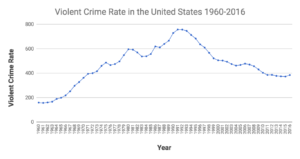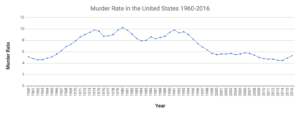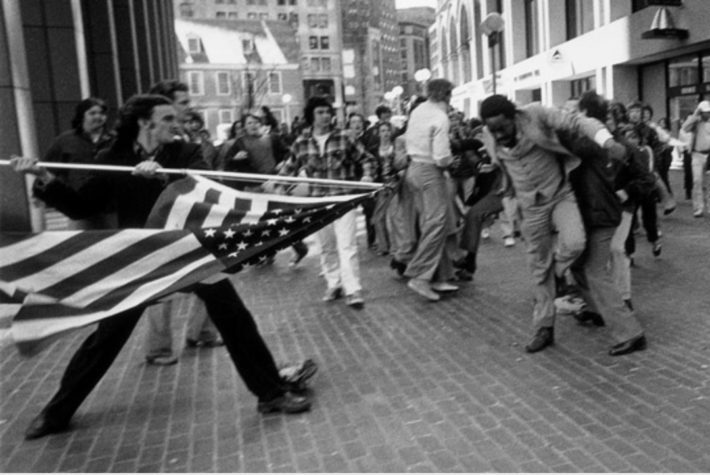Violence is about as American as apple pie or bad soccer. What true citizen of the red, white and blue doesn’t jump out of their seat and salute when they see it on the IMAX screen? Look, it’s a guy getting decapitated! Oh yeah. That’s fun.
Violence in the Media
Media violence has increasingly permeated western culture for the last 70 years or so, and we were just fine with that…mostly. As 24-hour news outlets and online overreactions have taken over the first world, society has started to develop a more ambivalent attitude. Just as much as we’ve embraced violence in our culture, we’ve resisted it and blamed it for almost all our problems.
You see, not everyone is as completely in love with violence as the rest of us degenerates are. Politicians and mothers have made their feelings very clear: films, video games, toys, music — these things are apparently turning our typical boys and men into violent, sociopathic killers. And I say typical “men” because men account for 75.6 percent of criminal violence. So, women, if you’re feeling left out here, either start committing more violent crimes or else try to get caught more often.
A History of Violence
As early as World War II, the American military was showing its infantry violent propaganda to amp them up for war. Some call it brainwashing or programming. Others suggest it’s still happening today. Was it effective? Was it unethical? Were there long-lasting aftereffects? It’s difficult to measure any direct impact. Outside of real war PTSD, studies are usually varied and inconclusive on these training methods.
But as wars passed, post-Vietnam America was fed up with violence. The “politically correct” movement was growing, and modern academia began conducting decades of research exploring what factors influence real world violence. And in spite of nebulous results at best, commercial America has bended and transformed to reflect our new sensitivities. Has it mattered? Well, let’s take a look at toys for example.
Toys on Target
As recently as the late 1980’s, toy guns still looked about as authentic as the real deal. Hell, there are old toy guns from the 70’s that are literally indistinguishable from actual firearms, and they were advertised as such. But as crime and tragedy started to dominate headlines, the toy companies were mandated to do something. Amidst the growing concern over police-related accidents, we started seeing brightly-colored plastic guns that were usually bulbous in size and very obviously toys. But the reported incidents of these mistaken police shootings still occur far too often. This could suggest a couple things:
But the reported incidents of these mistaken police shootings still occur far too often. This could suggest a couple things:
- 1) Obviously, we could guess police are just more trigger-happy than ever in this modern, violent world.
- 2) It’s possible that our ever-expanding media is simply picking up more of these stories, and awareness has grown with the internet and social media.
- 3) In a darker conspiracy, this stuff could have still happened with regularity back in the day, but it was far easier for police officers to cover their tracks.
- 4) Kids could be more brazen with their toy guns these days, leading to more aggressive reactions.
I’d be inclined to suggest it’s primarily a combination of 1 and 2, but that’s all just conjecture. The point is that the newer guns are often neon green plastic versions of what looks like a Martian ray gun in an Ed Wood film. And this design was intentional. But if we’re still going to be confronting these tragedies, kids may as well still be running around with their true-to-life toy revolvers and authentic looking M-16 squirt guns.
So in spite of all aesthetic changes, shootings and tragic incidents with law enforcement are still as prominent as ever, and they even rose as the 90’s kicked off. So perhaps it’s not all about toys. Maybe it’s video games and music that are cranking up that violence dial. They were certainly examined.
Video Game Scapegoats
In the early to mid-90’s, violent video games like Mortal Kombat and Doom came under fire for turning teens into monsters. Meanwhile, artists like Marilyn Manson became the latest scapegoats in music, which has been blamed for influencing evil since the dawn of rock and roll. The outrage over these products was only fueled by tragedies like the Columbine shooting in 1999, where both killers were known fans of Doom and Manson alike.
Of course, no impartial study being done at any level could identify any correlation whatsoever between violent behavior and these games and music. In spite of this, the terrified PC culture — led by lobbyists, angry moms, and out-of-touch politicians — pushed hard for changes. In response, we got parental advisory labels for music deemed unsavory. And we got the ESRB rating system for games, operating similarly to the MPAA for films.
And guess what? The rate of violent crime actually started to drop in the mid-90’s. Didn’t see that coming, did you? So the plan worked, right?
Well, we have to ask how much these restrictions and ratings had to do with this decline. Because nearly all studies were still failing to back up the suggestion that music, film, or video games affected violent tendencies. In fact, despite the general feeling in today’s America, violent crime and murder are at nearly 50-year lows (source: Politifact).


Since the early 2000’s, the rate of violent crime has seen small peaks and valleys, but it’s largely stayed somewhat consistent. It’s hard to posit that plastic toy guns or video games have any influence over this at all, if you’re looking strictly at the research. And if you do look at just the numbers, it’s difficult to identify any coinciding trends that don’t fly in the face of these studies.
Except for one. And it’s the same one that happens to falsely persuade us that all this violence in America is reaching an all time high. It’s the advent of the internet.
The New Boobtube
The world of online America started to rise rapidly in the mid-90’s, right as the violent crime rate started to fall — and by the turn of the century, high speed internet was consuming the country. People, and in particular young people, were now glued to the glowing rectangles in their homes. Then eventually, in their hands. And nobody has time to get arrested while they’re watching a viral video a fat guy falling off the roof. The internet literally started keeping people off the streets and out of trouble. Well, unless you consider massive porn addictions “trouble.”
And simultaneously, the endless cycles of news and information at our fingertips began to hypersensitize our fragile notions of security. These news outlets were now competing more than ever amongst each other. Fear mongering became the primary tool for captivating your consumer. Frightened people tune in more often, so crime and danger were played up and hyperbolized. Murderers and terrorists were glamorized. Horrifying the public was the new sensationalism.
This isn’t to say that all news is bad. But it’s also a cautionary tale to take a real look at the world around you: is it really more violent, or are you just more aware of violence? Are you just being told it’s more violent? Because, no matter what you’re feeling or hearing, violent crime is in fact down.
And while I’m crediting the internet for that slope to some degree, the truth is that we don’t truly know the primary factor for impacting violent trends. Perhaps it actually is video games and movies and toy guns. Perhaps it’s fewer people on the streets and more behind a laptop. Regardless, the point is that things are not quite as bad as they seem. People have been getting outraged at something or another for half a century now, and they may be shortening their lifespans for no reason.
Don’t Buy All the Hype
Occasionally, we need to stop, take a breath, and acknowledge that some things are getting better. We shouldn’t ignore our society’s problems, but we should be informed beyond the boogeymen that the talking heads try to scare us with. We’re spending too much time worrying and not enough time taking note of actual statistics.
Now get out there and attend a Marilyn Manson show; or watch Bruce Willis blow up a helicopter; or just get online and watch viral a video of a fat guy falling off the roof. I’m confident none of these things will be dangerous for anyone to consume. Well…unless you happen to be that fat guy on the roof.

